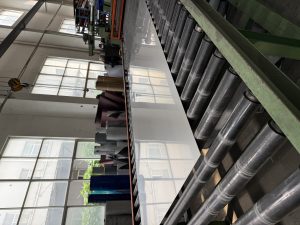430 stainless steel is a general-purpose steel with good corrosion resistance. Its thermal conductivity is better than that of austenite, its coefficient of thermal expansion is smaller than that of austenite, it is resistant to thermal fatigue, and it is added with stabilizing element titanium, so the mechanical properties of the weld are good.
430 stainless steel is used for architectural decoration, fuel burner parts, household appliances, and home appliance parts. 430F is a steel grade with easy-cutting properties added to 430 steel, and is mainly used for automatic lathes, bolts and nuts, etc. 430LX adds Ti or Nb to 430 steel, reduces C content, improves processing performance and welding performance, and is mainly used in hot water tanks, hot water supply systems, sanitary appliances, durable household appliances, bicycle flywheels, etc.
It is also known as 18/0 or 18-0 because of its chromium content. Compared with 18/8 and 18/10, it contains slightly less chromium and has a corresponding decrease in hardness.
Chemical Composition
Carbon (C): ≤0.12%
Silicon (Si): ≤0.75%
Manganese (Mn): ≤1.00%
Phosphorus (P): ≤0.040%
Sulfur (S): ≤0.030%
Nickel (Ni): ≤0.60% (can contain)
Chromium (Cr): 16.00~18.00%
Mechanical Properties
Density: 7.75g/cm³
Melting point: 1427°C
Expansion coefficient: mm/°C (at 20-100°C)
Young’s modulus: kN/mm²
Rigid modulus: kN/mm²
Application Standard: n/a (UNS)
Grading and Process
Surface Grade
430 stainless steel has the following states, different states, dirt resistance and corrosion resistance are also different.
NO.1, 1D, 2D, 2B, N0.4, HL, BA, Mirror, and various other surface treatment states.
Feature Processing Technology
- 1D—The surface has discontinuous granularity, also known as matte surface. Processing technology: hot rolling + annealing shot peening pickling + cold rolling + annealing pickling.
- 2D—Slightly lustrous silvery white. Processing technology: hot rolling + annealing shot peening pickling + cold rolling + annealing pickling.
- 2B—Silver white with better gloss and flatness than 2D surface. Processing technology: hot rolling + annealing shot peening pickling + cold rolling + annealing pickling + quenching and tempering rolling.
- BA—The surface has good gloss and high reflectivity, just like a mirror surface. Processing technology: hot rolling + annealing shot peening pickling + cold rolling + annealing pickling + surface polishing + temper rolling.
- No.3—has good glossiness and rough texture on the surface. Processing technology: Polishing and quenching and tempering rolling for 2D products or 2B with 100~120 abrasive materials (JIS R6002).
- No.4—has good glossiness and fine lines on the surface. Processing technology: 2D products or 2B are polished and tempered with 150~180 abrasive materials (JIS R6002).
- HL—silver gray with hairline streaks. Processing technology: Polish 2D or 2B products with abrasive materials of appropriate particle size to make the surface continuous grinding lines.
- MIRRO—in a mirror state. Processing technology: Grinding and polishing 2D or 2B products with abrasive materials of appropriate particle size to achieve a mirror effect.
Material Properties
430 stainless steel has the ability to resist oxidation to corrosion, but has a tendency to intergranular corrosion.
430 stainless steel wire is widely used in shafts.
Because it is safe and non-toxic, it is widely used in food tableware.




